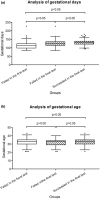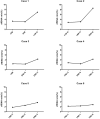Reasons for failure of noninvasive prenatal test for cell-free fetal DNA in maternal peripheral blood
- PMID: 38284448
- PMCID: PMC10795076
- DOI: 10.1002/mgg3.2351
Reasons for failure of noninvasive prenatal test for cell-free fetal DNA in maternal peripheral blood
Abstract
Background: To explore reasons for the failure of noninvasive prenatal test (NIPT) for cell-free fetal DNA (cffDNA) in maternal peripheral blood, and discuss appropriate treatment schemes after the failure of the test.
Methods: Altogether 41,136 pregnant women participated in NIPT. Blood samples were taken again from pregnant women who failed the first blood collection upon their informed consent. Prenatal genetic counseling or prenatal diagnosis was recommended for pregnant women with final NIPT failure.
Results: The first failure rate of NIPT was 0.737% (303/41136), and the reason for the failure was the low ratio of cffDNA in 135 (44.6%) of the 303 pregnant women. After the second or third blood sampling, the final failure rate was 0.182% (75/41136). The low ratio of cffDNA was the main reason for test failure in 42 (56.0%) of the 75 pregnant women who finally failed NIPT, among whom 44 (58.7%) had underlying diseases, including 21 (47.7%) with more than two coexisting underlying diseases. Only 27 (36.0%) of the 75 pregnant women with NIPT failure underwent interventional prenatal diagnosis.
Conclusions: The main reason for NIPT failure was the low ratio of cffDNA. Postponing the gestational weeks of blood collection may improve the success rate. Resampling and retesting upon informed consent in pregnant women who failed the first test could improve the success rate. For pregnant women who finally failed NIPT, it is suggested strengthening the genetic counseling, prenatal examination, and ultrasound evaluation, and carry out interventional prenatal diagnosis if necessary.
Keywords: NIPT; cffDNA; failure.
© 2024 The Authors. Molecular Genetics & Genomic Medicine published by Wiley Periodicals LLC.
Conflict of interest statement
The authors declare that the research is conducted in the absence of any commercial or financial relationships that could be construed as a potential conflict of interest.
Figures



Similar articles
-
[Influencing factors of resampling failure for non-invasive prenatal testing and its influence on pregnancy outcomes].Zhonghua Fu Chan Ke Za Zhi. 2025 Apr 25;60(4):268-274. doi: 10.3760/cma.j.cn112141-20240822-00464. Zhonghua Fu Chan Ke Za Zhi. 2025. PMID: 40287389 Chinese.
-
[Preliminary analysis of the cause for the failure of non-invasive prenatal testing using cell-free fetal DNA derived from peripheral maternal blood].Zhonghua Yi Xue Yi Chuan Xue Za Zhi. 2018 Jun 10;35(3):329-333. doi: 10.3760/cma.j.issn.1003-9406.2018.03.005. Zhonghua Yi Xue Yi Chuan Xue Za Zhi. 2018. PMID: 29896725 Chinese.
-
[Comparison of two superparamagnetic purification magnetic beads-based screening and enrichment techniques for isolating cell-free fetal DNA from maternal plasma for non-invasive prenatal screening].Zhonghua Yi Xue Yi Chuan Xue Za Zhi. 2024 Jul 10;41(7):797-802. doi: 10.3760/cma.j.cn511374-20230508-00268. Zhonghua Yi Xue Yi Chuan Xue Za Zhi. 2024. PMID: 38946360 Chinese.
-
[Non invasive prenatal test (NIPT) in maternal blood by parallel massive sequencing. Initial experience in Mexican women and literature review].Ginecol Obstet Mex. 2015 May;83(5):277-88. Ginecol Obstet Mex. 2015. PMID: 26233973 Review. Spanish.
-
Maternal Plasma DNA and RNA Sequencing for Prenatal Testing.Adv Clin Chem. 2016;74:63-102. doi: 10.1016/bs.acc.2015.12.004. Epub 2016 Jan 21. Adv Clin Chem. 2016. PMID: 27117661 Review.
Cited by
-
A Decade of Non-Invasive Prenatal Testing (NIPT) for Chromosomal Abnormalities in Croatia: First National Monocentric Study to Inform Country's Future Prenatal Care Strategy.Genes (Basel). 2024 Dec 11;15(12):1590. doi: 10.3390/genes15121590. Genes (Basel). 2024. PMID: 39766857 Free PMC article.
-
Healthcare professionals' perspectives on and experiences with non-invasive prenatal testing: a systematic review.Hum Genet. 2025 Apr;144(4):343-374. doi: 10.1007/s00439-025-02736-y. Epub 2025 Apr 9. Hum Genet. 2025. PMID: 40205233 Free PMC article.
References
-
- Borth, H. , Teubert, A. , Glaubitz, R. , Knippenberg, S. , Kutur, N. , Winkler, T. , & Eiben, B. (2021). Analysis of cell‐free DNA in a consecutive series of 13,607 routine cases for the detection of fetal chromosomal aneuploidies in a single center in Germany. Archives of Gynecology and Obstetrics, 303(6), 1407–1414. 10.1007/s00404-020-05856-0 - DOI - PMC - PubMed
-
- Grömminger, S. , Erkan, S. , Schöck, U. , Stangier, K. , Bonnet, J. , Schloo, R. , Schubert, A. , Prott, E. C. , Knoll, U. , Stumm, M. , von Kalle, C. , & Hofmann, W. (2015). The influence of low molecular weight heparin medication on plasma DNA in pregnant women. Prenatal Diagnosis, 35(11), 1155–1157. 10.1002/pd.4668 - DOI - PubMed
-
- Health and Family Planning Committee, P. R. China . (2016). Technical specification for prenatal screening and diagnosis of fetal free DNA in maternal peripheral blood[S].
MeSH terms
Substances
Grants and funding
LinkOut - more resources
Full Text Sources
Medical

